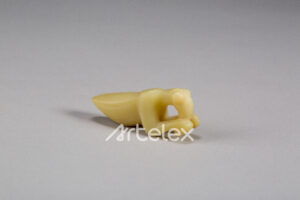This artifact is a jade carving believed to represent a mantis, originating from the Hongshan culture. Made of yellow jade, the surface shows signs of natural aging over centuries. The creature’s head is large and triangular, featuring a protruding, beak-like nose and an open mouth that resembles a yawn.
Most notably, the figure has two sharp, bent front legs characteristic of a mantis, which are used for grasping prey. These limbs express not only biological accuracy but may also hold symbolic or ritual significance.
Mantis-shaped jade carvings in Hongshan culture are known to have been produced only during the early and middle periods. No such forms have been discovered from the late Hongshan phase, making this piece particularly valuable for dating and interpretation. It likely symbolizes vitality, hunting instincts, or spiritual power within ceremonial contexts.

